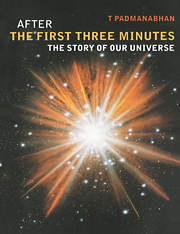8 - Open questions
Published online by Cambridge University Press: 02 November 2009
Summary
The broad picture
In the previous chapters, we have explored the conventional thinking of cosmologists and astrophysicists in their attempt to understand the structures in the universe. Some of these attempts have been very successful, while others must be still thought of as theoretical speculations. Since different aspects of structure formation were touched upon in different chapters of this book, it is worthwhile to summarize the conventional picture in a coherent manner.
The key idea behind the models for structure formation lies in treating the formation of small-scale structures like galaxies, clusters, etc. differently from the overall dynamics of the smooth background universe. This is linked to the assumption that, in the past, the universe was very homogeneous with small density fluctuations.
The evolution of the smooth universe is well described by the standard big bang model. Starting from the time when the universe was about one second old, one can follow its evolution till the time when matter and radiation decoupled – which occured when the universe was nearly 400 000 years old. During this epoch, the energies involved in the physical processes ranged from a few million electron volts to a few electron volts. This band of energies has been explored very thoroughly in the laboratory experiments dealing with nuclear physics, atomic physics and condensed matter physics. We understand the physical processes operating at these energy ranges quite well, and it is very unlikely that theoretical models based on this understanding could go wrong. In other words, we can have a reasonable amount of confidence in our description of the universe when it evolved from an age of one second to an age of 400 000 years.
- Type
- Chapter
- Information
- After the First Three MinutesThe Story of Our Universe, pp. 192 - 203Publisher: Cambridge University PressPrint publication year: 1998

